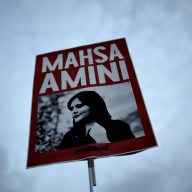 Shailene Woodley hosts a preview screening of her new indie “White Bird in a Blizzard.”
Shailene Woodley hosts a preview screening of her new indie “White Bird in a Blizzard.”
Credit: Getty Images
Shailene Woodley hugs you if you’re interviewing her in person. “It just gives us more of a connection,” the actress says. She doesn’t seem an untouchable star with two major hits — “Divergent” and “The Fault in our Stars” — this year alone. In fact, the film she’s peddling couldn’t be more different.“White Bird in a Blizzard” isa small, color-coded, very sex-positive blend of drama, comedy and mystery from one-time indie and New Queer Cinema bad boy Gregg Araki (“The Doom Generation”), who honestly hasn’t exactly mellowed, even in his 50s.
Woodley couldn’t wait to work with Araki, having been blown away years ago by his most acclaimed film, 2004’s “Mysterious Skin,” a look at child abuse that featured a breakthrough performance from Joseph Gordon-Levitt. “It was so beautiful, haunting and different,” she effuses. “There were so many layers and levels to it that I never experienced before in a film. I’d never seen a movie that affected me like that.”
“White Bird” isn’t far from “Mysterious Skin.” It stars Woodley as Kat, a high schooler in the 1980s who one day discovers her faintly insane housefrau mother (Eva Green, who in real life is only 11 years her senior) has vanished without a trace. But Kat’s life goes on, even as she heads off to college, as well as bounces from a boyfriend (Shiloh Fernandez) to skeezy hook-ups with a macho detective (Thomas Jane).
Woodley didn’t have to do too much research into the music of the period, which is draped in Depeche Mode and The Cure. “I grew up with an older sister, and she was so into that music when I was a young teenager. She was more the outcast coolest girl in school, who listened to the good music,” she explains. “One thing I love about Kat is she’s not a Goth, she’s not punk, she’s not grunge. She’s this eclectic, alternative mix of a bunch of different things.”
Like most Araki films, “White Bird” is carefree with sex, which was fine with Woodley. “Most adolescent films explore all the heartbreak and first love, but never explore the sexuality factor, which is huge,” she says. “That’s the defining thing of adolescence, figuring out who you are sexually — being scared of it, being excited by it, being liberated from it and nervous about it and in competition with others. There are so many different elements that are involved that no one really explores in movies.”
 Shailene Woodley canoodles with Shiloh Fernandez in “White Bird in a Blizzard.”
Shailene Woodley canoodles with Shiloh Fernandez in “White Bird in a Blizzard.”
Credit: Magnolia Pictures
She doesn’t think the period setting makes it a mere nostalgia piece. “I feel people are the same emotionally then as they are nowadays,” Woodley says. One could even think it was set in the today — until they notice the lack of cellphones. Woodley says tech isn’t just a millennial thing: “I know more grandmas out there who use their phones more than I do.”
Woodley herself tries to limit her own smartphone usage. “Once you start you can’t stop. Once you start looking at things you think, Now I’m going to look at this. All of a sudden it’s time for bed. It’s easier to just not go there. It’s like a really good cake. I can’t just have one bite. I’ll want the whole cake,” she says.
She’s also reluctant to allow social media to help her create a fake, viral identity. “It feeds insecurity, because it gives all your own worth and power and validation to those you don’t know over the Internet,” she explains. “Instagram is all about a story. It’s all about, ‘Look how interesting I am, how neat my life is, and I want you to like it so I feel validated even though I don’t know you.’”
But she doesn’t hate all social media: “I think Twitter’s actually really genius, because you can wake up in the morning and you have a feed of the things you’re interested in. I can wake up and go, I have this amazing women’s website and I’ve got The New York Times and I’ve got this anti-fracking thing that’s giving me updates. It’s like a personalized newspaper. I think it’s smart but it’s just abused.”
In any case, her own work helps tell a narrative about her for her. “It’s very rare that people’s jobs serve as their family photo albums. You get to watch your movies and think, That’s who I was then. I get to see ‘White Bird,’ which I did two years ago, and be like, Wow, I was such a different person then, such a different human,” she says. (Indeed her flowing hair seen in the film has not only been chopped but is now dyed blonde on the top.) “It’s such a gift. Most jobs it’s up to Kodak to manage your memories. Our job does it for us.”
Not that her films tell her whole story. “No matter how public something is, it’s still so personal.”
Follow Matt Prigge on Twitter @mattprigge















